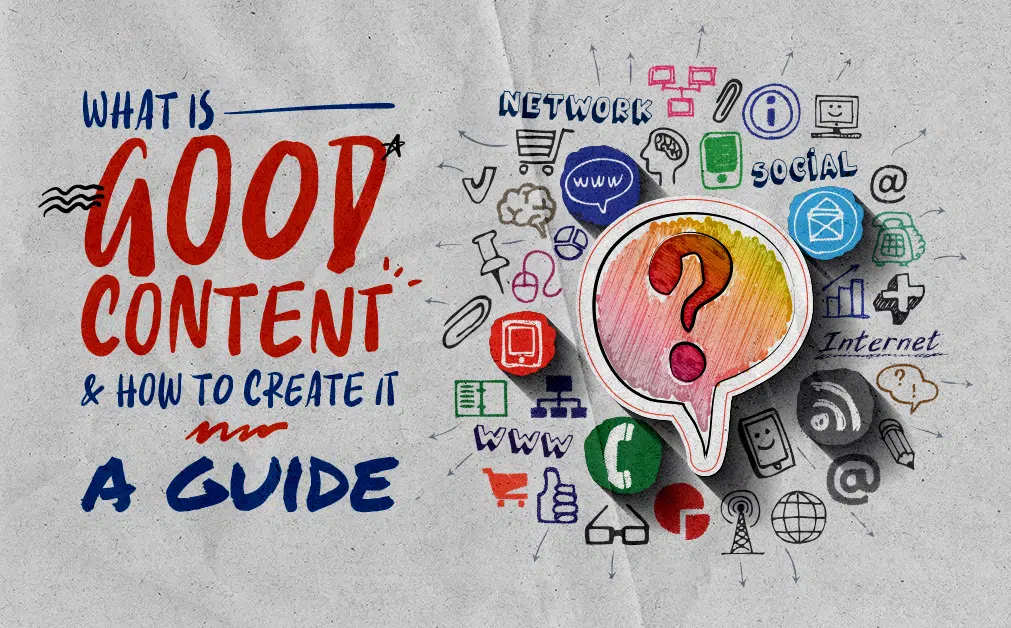Feeling lost trying to figure out what good content actually is? You’re not alone.
Many business owners struggle with knowing what makes content effective and how to actually produce it. You hear ‘content is king’ everywhere, but what does that really mean for your business?
Understanding what is good content and how to create it is the first step toward cutting through the noise and building something that truly connects with your audience.
Let’s break down what good content involves and exactly how you can start the content creation process. We will explore what good content is and how to create it. This understanding is fundamental to any marketing strategy.
Good content isn’t just about stringing words together or posting pretty pictures on a social media platform. It’s about connecting with the people you want to reach, aiming to solve problem areas they face, and establishing trust. Think of it as the bridge between your business and your potential customers, making the subject matter relevant and helpful.
Getting this right helps people find you, like you, and ultimately, choose you over the competition. High-quality written content or media content can significantly impact search engine rankings. This exploration will cover what is good content and how to create it effectively.
Get your FREE Marketing Check Up now!
Table of Contents
- Understanding the Core of Good Content
- Experience: Have You Walked the Walk?
- Expertise: Do You Really Know Your Subject?
- Authoritativeness: Are You a Go-To Source?
- Trustworthiness: Can People Rely on You?
- Defining Your Content Goals
- Knowing Your Audience Inside Out
- What is Good Content and How to Create It: The Process
- 1. Research and Ideation
- 2. Planning Your Content
- 3. Creating the Content
- 4. Editing and Optimisation
- 5. Promotion and Distribution
- 6. Measuring and Analysing Performance
- Types of Good Content You Can Create
- Making Your Content Stand Out
- Consistency is Your Friend
- Conclusion
Understanding the Core of Good Content
So, what separates the truly great content from the rest? It boils down to a few key things. At its heart, good content is useful, relevant, and engaging for your specific audience.
It needs to speak directly to their needs, challenges, or interests, aligning with their search intent. If your audience doesn’t find it helpful or interesting, it simply won’t work, no matter how much effort you put into producing content. Your content pieces need to hit the mark every single time.
Google talks a lot about E-E-A-T, which stands for Experience, Expertise, Authoritativeness, and Trustworthiness. While this sounds technical, it’s really about creating content that shows you know your stuff and that people can rely on what you say. Demonstrating real-world experience adds significant weight and contributes to high quality output.
Experience: Have You Walked the Walk?
Showing experience means proving you’ve actually done what you’re talking about. Did you use a product yourself before reviewing it? Have you implemented the strategy you’re teaching in your own content production?
Sharing personal stories, case studies, or specific examples from your own work helps build credibility. People connect with real experiences far more than abstract theories; this adds a crucial personal touch.
Authenticity resonates, making your content piece more believable and relatable. This practical application separates theory from proven practice.
Expertise: Do You Really Know Your Subject?
Expertise is about demonstrating deep knowledge in your field. This doesn’t mean you need a PhD, but you should be able to cover a topic thoroughly and accurately. Back up your claims with facts or insights when crafting content.
Go beyond surface-level information and address the underlying questions. Answer the questions your audience is really asking, maybe even the ones they haven’t thought of yet. This demonstrates genuine understanding.
Being a source of deep knowledge positions you as a reliable resource in your niche. This depth is vital for creating truly valuable content.
Authoritativeness: Are You a Go-To Source?
Authority comes when others recognise your expertise. This can be built over time through consistent, high-quality content. Things like positive reviews, testimonials, mentions from other respected sources, and acquiring quality backlinks help build this perception.
Think about becoming the recognised voice in your niche. When people have questions about your industry, you want them to think of you first. Consistent content produce reinforces this status.
Building authority improves your brand’s reputation and can positively influence engine rankings. It signals to search engines that your site is a credible source.
Trustworthiness: Can People Rely on You?
Trust is perhaps the most important element. People need to feel safe engaging with your content online and your business. This means being transparent, honest, and reliable.
Make sure your website is secure (HTTPS), a basic but essential step. Have clear contact information and privacy policies readily accessible. Cite your sources properly and correct any mistakes quickly; this honesty fosters trust.
Transparency in your content creation strategy and business practices is fundamental. Without trust, even the best content may fail to connect or convert.
Defining Your Content Goals
Before you even think about writing a single word or planning a media post, you need to know why you’re creating content in the first place. What do you want to achieve? Without clear marketing goals, your content creation efforts will lack direction and purpose.
Are you trying to attract more visitors to your website and improve seo performance? Maybe you want to generate more leads or increase sales. Or perhaps your goal is simply to build brand awareness and position yourself as a thought leader.
Setting SMART goals (Specific, Measurable, Achievable, Relevant, Time-bound) is a great approach. For instance, instead of ‘get more leads’, a SMART goal would be ‘Increase marketing qualified leads generated through blog posts by 15% in the next quarter’. This clarity guides your content strategy.
Create your marketing plan template here.
Knowing Your Audience Inside Out
Who are you actually trying to reach? You can’t create high-impact content without deeply understanding your target audience. You need to know more than just basic demographics like age or location.
What are their biggest challenges and pain points? What are their goals and aspirations? What kind of questions are they asking search engines, revealing their search intent?
Create detailed buyer personas, representing your ideal customers. Give them names, personalities, and backstories based on real data and customer insights. This makes it easier to step into their shoes when creating content online and ensures your content doesn’t miss the mark.
You can gather this information through customer surveys, interviews, social media listening (monitoring social media platforms), and analysing website analytics. Look at online forums like Reddit or Quora where your potential customers hang out. What are they talking about, what language do they use?

What is Good Content and How to Create It: The Process
Alright, you understand what makes content good, you’ve set your goals, and you know your audience. Now, how do you actually sit down and create content? It involves a clear process, a well-defined creation strategy.
Don’t just jump straight into writing or recording. Planning and research are vital first steps.
Let’s look at a practical process you can follow for successful content marketing.
1. Research and Ideation
This is where you brainstorm topics and research specific keywords. What subjects align with your audience’s needs and your business expertise? What terms are people actually searching for online that you can target?
Use marketing tools like Google Keyword Planner, Semrush, or Ahrefs to find relevant keywords. Look for terms with decent search volume but also consider long-tail keywords, which are more specific and often indicate stronger intent. For example, instead of just ‘content marketing’, try ‘content marketing strategies for small businesses’.
Analyse your competitors’ content; see what content creators in your space are doing. What topics are they covering? Where are the gaps you could fill, or angles they haven’t explored? Tools like AnswerThePublic can show you the questions people are asking around a specific keyword, helping shape your content writing.
2. Planning Your Content
Once you have ideas, you need a plan, often documented in a content marketing strategy. A content schedule or publishing schedule is your best friend here. Map out what content you’ll publish, when, and on which channels, like various media platforms.
Outline each content piece before you create it. What key points will you cover? What structure will it follow? What is the main message or takeaway for the reader?
Decide on the format. Will it be a blog post, a video, an infographic, a podcast, or perhaps a series of social media posts? The best format often depends on the topic, the target media platform, and your audience’s preferences. Sometimes repurposing one core idea into multiple formats works well, maximising your content production efforts.
3. Creating the Content
Now it’s time for the actual creation, the core of producing content. Focus on providing value and clarity. Write in a natural, conversational tone – imagine you’re talking directly to one of your ideal customers.
Break up text with headings, subheadings, bullet points, and short paragraphs, like this one. This improves readability, especially for people scanning online. Incorporate relevant images, videos, or graphics to make it more engaging and keep your audience engaged.
Make sure your content directly answers the question or solves the problem suggested by your title and introduction. Don’t forget to include a clear call-to-action (CTA) telling people what you want them to do next. This could be downloading a guide, signing up for a newsletter, or contacting you for a consultation.
4. Editing and Optimisation
Never publish your first draft; careful editing is essential for high impact output. Editing is essential for catching errors, improving flow, and refining your message. Read it aloud to spot awkward phrasing or unnatural sentences.
Check for clarity, conciseness, and consistency in tone and style. Does it align with your brand voice? Is the information accurate and up-to-date, ensuring your existing content doesn’t become stale content?
Optimise your content for search engines (SEO) to improve search engine rankings. This involves naturally incorporating your target keywords (don’t stuff them.), writing compelling meta descriptions and title tags, and using alt text for images. You can find helpful basics in Google’s SEO starter guide.
5. Promotion and Distribution
Creating great content isn’t enough; you need to get it in front of the right eyes. Develop a plan for promoting each content piece. Share it on relevant social media channels through well-crafted social media posts or media posts.
Email marketing is powerful for distributing your content online. Send your new content to your email list. Consider reaching out to influencers or other websites in your niche for potential collaborations or shares, which can also help generate quality backlinks.
Think about paid promotion if your budget allows. Platforms like Google Ads or social media marketing options on various media platforms can help amplify your reach to a targeted audience. Effective distribution is key to maximising the impact of your content creation efforts.
6. Measuring and Analysing Performance
How do you know if your successful content is actually working? You need to track its performance against the marketing goals you set earlier. Use tools like Google Analytics to monitor key metrics related to your content strategy.
Look at things like page views, time on page, bounce rate, social shares, comments, and conversion rates (e.g., lead form submissions). Which pieces of content are performing best? What topics resonate most with your audience and drive engagement?
Use these insights to refine your creation strategy. Do more of what works and adjust or stop doing what doesn’t perform well. Content creation is an ongoing cycle of learning, analysis, and improvement, impacting your overall seo performance.
Read more about how to measure your marketing ROI.

Types of Good Content You Can Create
Variety keeps things interesting for your audience and allows you to reach them on different media platforms. Don’t just stick to one format for all your content pieces.
Here are a few types of content that often perform well:
- Blog Posts: Informative articles, how-to guides, listicles, thought leadership pieces exploring a specific subject matter.
- Videos: Tutorials, demonstrations, interviews, behind-the-scenes looks, webinars. Video consumption continues to rise significantly, making it a vital format for many content creators.
- Infographics: Visually engaging ways to present data, statistics, or complex processes.
- Case Studies: Detailed stories showing how you helped a client achieve success. These build trust and provide social proof for your brand’s reputation.
- Ebooks & Guides: In-depth resources on a specific topic, often used as lead magnets to capture contact information. This is often considered valuable content.
- Podcasts: Audio content for audiences who prefer listening on the go or during commutes.
- Templates & Checklists: Practical tools that provide immediate value to your audience, helping them solve problem areas quickly.
- Social Media Content: Tailored social media posts for platforms like LinkedIn, Instagram, Facebook, or Twitter, designed for engagement on those specific social media platforms.
Mix and match these formats based on your resources, audience preferences, and content goals. Remember that repurposing is key. A detailed blog post could become a video script, an infographic, or several media posts for social channels.
Consider creating evergreen content – information that remains relevant and valuable for a long time. This type of content can consistently attract traffic and leads, well after its initial publication date.
Making Your Content Stand Out
The internet is crowded with content generated daily. How do you make sure your content cuts through? It’s not just about quality; it’s also about being memorable and distinct.
Develop a distinct brand voice. Are you informative and serious, or more conversational and humorous? Consistency in tone across all content produce helps people recognise and connect with your brand, contributing to audience consistency in perception.
Tell stories. Humans are wired for narrative. Weaving stories into your content makes it more relatable and memorable, adding that essential personal touch. Share your own experiences or those of your customers (with permission, of course).
Focus on a specific niche. Trying to appeal to everyone often results in appealing to no one. Becoming the expert in a focused area helps you attract a loyal audience who see you as the authority on that subject matter.
There isn’t one specific secret making content stand out, but authenticity, value, and a clear voice are must have ingredients. Understanding your audience allows you to tailor this approach effectively.

Consistency is Your Friend
Creating one great piece of content is good, but consistency is what builds momentum and audience loyalty. You need to publish content consistently. This doesn’t necessarily mean daily, but find a posting schedule you can realistically stick to.
Whether it’s weekly, bi-weekly, or monthly, audience consistency in publishing signals to both your audience and search engines that you are active and reliable. A content calendar (part of your content creation strategy) helps tremendously here. Plan ahead so you’re not scrambling for ideas at the last minute.
Remember, quality always trumps quantity when you produce content. It’s better to publish one truly valuable piece of evergreen content per month than four mediocre ones per week. Find the balance that works for your business, maintains high quality, and keeps your audience engaged without leading to burnout for your content creators.
Regularly updating existing content is also part of consistency. This prevents information from becoming outdated (stale content) and shows search engines that your content remains fresh and relevant.
Conclusion
Figuring out what is good content and how to create It is a continuous process, not a destination. It’s about understanding your audience deeply, setting clear marketing goals, and committing to providing genuine value through your content creation efforts. Good content addresses needs, answers questions, builds trust through establishing trust, and ultimately helps grow your business.
Focus on E-E-A-T: Experience, Expertise, Authoritativeness, and Trustworthiness in all the content you produce. Follow a structured process encompassing research, planning, content writing or creation, promotion using social media marketing and other channels, and analysis with marketing tools. Be consistent with your publishing schedule, find your brand voice, and never stop learning about what resonates with the people you want to serve.
Start small, measure your results to gauge SEO performance and audience reaction, and refine your content marketing strategy over time. With dedication and a focus on value, you can master the art of creating impactful content online. You’ve got this!
Connect with me on LinkedIn
